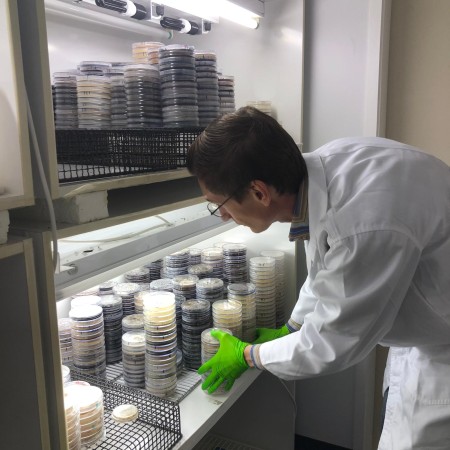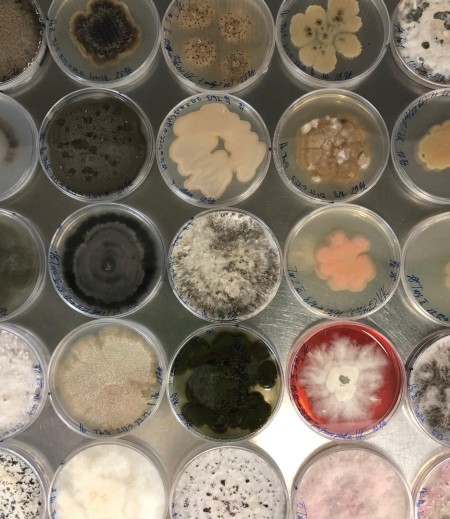The colourful, culturable seed-borne microbiome of pōhutukawa
Just like humans, plants have their own microbiomes. Microbes colonise the roots of plants like legumes to help with nitrogen fixation and the uptake of important nutrients. Microbes also colonise the aboveground parts of plants, including the stems, bark, and leaves. These microbes may live on the surfaces of the plants or even inside the cells. The “good” microbes contribute to the healthy functioning of the plant. The “bad” microbes, or the pathogens, can hurt plants, especially if plant health is compromised by other stress like drought.
 Vladislav Kholostiakov, a PhD student with the Beyond Myrtle Rust programme, has been studying the microbiome of pōhutukawa seeds. His overall hypothesis is that seedlings of pōhutukawa may contain seed-derived microbial communities that contribute to variation in susceptibility to Austropuccinia psidii, a microbe in its own right and the causal agent of myrtle rust.
Vladislav Kholostiakov, a PhD student with the Beyond Myrtle Rust programme, has been studying the microbiome of pōhutukawa seeds. His overall hypothesis is that seedlings of pōhutukawa may contain seed-derived microbial communities that contribute to variation in susceptibility to Austropuccinia psidii, a microbe in its own right and the causal agent of myrtle rust.
To test his hypothesis, Vlad collected ripe seed capsules from healthy trees at three sites in urban Auckland and regional parks outside the city (Tāwharanui, Wenderholm, and Whangaparāoa | Shakespear). Vlad isolated the microbes from the seeds by placing drops of an infusion made from the crushed seeds of each tree onto a cultivation media in a Petri dish. Then he waited to see what grew. Bacterial colonies and fungal hyphae that emerged were transferred to new Petri dishes, so that each dish eventually contained (hopefully) only one microbial species.
I had the privilege of visiting Vlad in the lab and meeting these unique microbes in person. I’d read about microbial diversity – yeasts, Bacillota, Actinomycetota – but I was amazed by how different they all looked. There was pink puffy candyfloss, slimy beige blobs, iridescent black growths and a particularly scary looking white snowflake bloom that had turned the surrounding medium a vibrant red.
“Yes, that one is actually a pathogen,” Vlad told me.
The significance of all this diversity is unpacked in Vlad’s recent publication. After identifying each microbe as best he could (and using DNA sequencing), Vlad was able to identify 412 fungal isolates and 156 bacterial colonies. By reviewing literature, Vlad then assessed how many of these were beneficial, neutral, pathogenic or played an unknown role in plant health.
 Among the bacteria, 12 species were classed as beneficial to plants with either (1) well-documented activity against phytopathogens and/or (2) growth-promoting properties, which include plant hormone production and nutrient acquisition. Nine species of isolated bacteria are known to be direct fungal antagonists, capable of inducing resistance to pathogens in some plants.
Among the bacteria, 12 species were classed as beneficial to plants with either (1) well-documented activity against phytopathogens and/or (2) growth-promoting properties, which include plant hormone production and nutrient acquisition. Nine species of isolated bacteria are known to be direct fungal antagonists, capable of inducing resistance to pathogens in some plants.
Among the fungi, nine have been effectively applied as biocontrol agents in other settings. In addition, Papiliotrema flavescens has been isolated from healthy foliage and rust pustules of A. psidii and, therefore, is considered to be a putative hyperparasite of A. psidii. But not all fungi are good guys – two fungal taxa that Vlad found are known to cause fruit rot and seed damage to various trees, including Eucalyptus and Syzygium species. The rest of the isolated fungi were represented by endophytes without any known function.
Interestingly, the number of fungal isolates found did not differ between rural and urban locations. But for the overall isolation rate of all microorganisms, bacteria and fungi, trees sampled from Wenderholm Regional Park had the highest number of isolations, while Tāwharanui displayed the lowest number, with the difference between those two locations being statistically significant and the isolation rates at other locations lying somewhere in between.
There’s a lot more in the paper, but one of the big take-homes for me was that this research provides the first insight into the bacterial and fungal communities of pōhutukawa seeds. It also identified microorganisms that may help or hinder plant growth, and some that may actively fight A. psidii… or in some cases compound the damage it causes.
If you’d like the full story, be sure to check out Vlad’s paper here. Otherwise, stay tuned via the BioHeritage newsletter and social media for updates in Beyond Myrtle Rust research.
Jenny Leonard




